Reversed polarity in foods may sound like science fiction, but it’s a real concept that plays a big role in how our food heats up, cooks, and even tastes. It deals with how the tiny molecules inside your food behave—especially under things like microwaves, electromagnetic energy, or certain types of processing.
This article breaks down what reversed polarity really means in simple terms, why it happens, and what effects it has on the food we eat every day. We’ll look at the problems, solutions, and the surprising ways it can be both helpful and harmful. Let’s get into it.
Understanding Reversed Polarity in Foods
What Does Reversed Polarity Mean in Simple Terms?
Polarity in food refers to the way molecules—especially water—are aligned. Water is a polar molecule, meaning it has a positive end and a negative end. These charges help water molecules stick together and react to heat or electricity in special ways.
Reversed polarity means those charges get flipped. This usually happens when electromagnetic energy from something like a microwave disrupts the normal balance of molecules.
How Polarity Affects Molecules in Food
In regular cooking, water and other polar molecules move in a certain direction. When polarity is reversed, molecules move the other way. This can change the temperature, texture, and even flavor of your food. It’s kind of like flipping a magnet—the attraction and movement change completely.
Common Problems Linked to Reversed Polarity
Uneven Heating in Microwaved Meals
One of the most common places reversed polarity shows up is in microwaved foods. If you’ve ever had a meal that’s boiling hot in one spot and ice cold in another, reversed polarity is partly to blame. The way microwaves interact with polar molecules can cause uneven heating patterns.
Loss of Nutrients in Processed Food Items
Certain vitamins and enzymes, like vitamin C and enzymes in fruits, are sensitive to how they’re heated. When polarity flips, it may cause these molecules to break down faster, which means fewer nutrients in your food. This can happen in frozen dinners, reheated leftovers, or canned goods.
Taste and Texture Alterations
Foods like meat, cheese, and vegetables may taste different or feel rubbery after being microwaved. This isn’t just bad luck—it’s a result of molecular misalignment. The reversed polarity changes how moisture is retained, which affects the softness or chewiness of food.
Foods Most Affected by Polarity Reversal
High-Water Content Vegetables and Fruits
Foods with a lot of water, such as zucchini, tomatoes, or watermelon, are more likely to show signs of reversed polarity. The water molecules inside them are quick to respond to electrical changes, making them heat unevenly or lose texture fast.
Processed and Frozen Convenience Foods
Items like TV dinners, microwavable soups, or pre-cooked rice can suffer from polarity shifts. These meals are often pre-treated, frozen, and then reheated—three chances for polarity issues to occur. That’s why the taste may not match the appearance.
Scientific Explanation Behind Reversed Polarity
Electromagnetic Fields and Molecular Realignment
When you place food in a microwave oven, it gets hit by electromagnetic waves. These waves cause the polar molecules to spin or align in different directions. In some cases, this realignment causes the polarity to flip, creating hotspots or cold zones.
The Role of Water Molecules in Polarity Shifts
H₂O, or water, is a big deal here. Because it’s a polar molecule, it reacts more quickly to changes in electromagnetic fields than fats or carbohydrates. So when water’s polarity changes, everything around it—like sugars or salts—starts to behave differently too.
Solutions and Preventive Measures
Proper Heating Techniques to Maintain Nutrient Integrity
Use lower microwave settings or the stir-and-stand method. This allows heat to move more evenly, preventing molecular stress and nutrient loss. Cooking slowly and evenly keeps polarity from reversing too quickly.
Choosing Appliances That Distribute Energy Evenly
Some microwaves come with inverter technology or turntables. These help deliver heat in a more balanced way, avoiding sudden polarity flips. Using convection ovens or air fryers for reheating can also preserve the natural structure of food.
Packaging Technologies That Preserve Original Structure
Smart packaging lined with heat-dispersing materials can help maintain polarity. Look for labels that say “microwave-safe with even-heating film” or similar. These materials are designed to stop polarity reversal from making your food soggy or chewy.
Potential Benefits of Controlled Polarity Reversal
Enhanced Absorption of Nutrients
When controlled, polarity reversal might actually boost bioavailability. For example, some antioxidants in fruits and veggies become more active after mild heating. This could make certain nutrients easier for the body to absorb.
Modified Texture for Culinary Creativity
In molecular gastronomy, chefs use polarity shifts to alter textures on purpose. Foods like foams, gels, and spheres rely on carefully changed polarity to hold their shape and flavor. So, in a lab kitchen, reversed polarity becomes a tool—not a problem.
Conclusion: Is Reversed Polarity Harmful or Helpful?
Context Matters: Natural vs. Artificial Changes
Reversed polarity isn’t automatically bad. It depends on how, when, and why it happens. Natural changes during cooking can be fine, but repeated, uncontrolled flips—like constant microwaving—may affect taste and nutrition.
What to Watch for in Packaged or Microwaved Foods
Look out for signs like:
- Soggy edges
- Burnt centers
- Tough textures
- Faded flavors
These often signal polarity issues. Using smart heating methods and understanding what causes molecular flips can help you enjoy better meals.
By knowing how reversed polarity in foods works, you’re not just eating—you’re thinking like a food scientist. Next time your pizza slice is hot in the middle but cold on the crust, you’ll know what’s going on inside at the molecular level. Now that’s food for thought.

